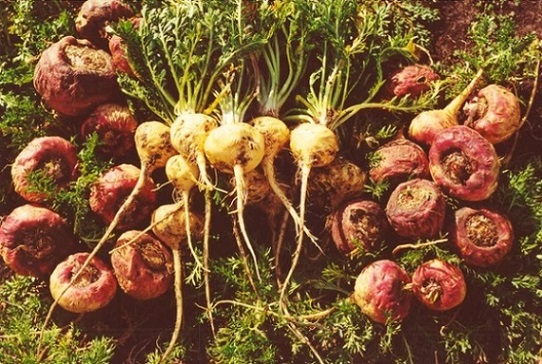Exploring Natural Compounds Derived from Peruvian Maca (Lepidium Meyenii) to Tackle Glioblastoma Multiforme
Nikhil Prasad Fact checked by:Thailand Medical News Team Jan 13, 2025 3 months, 8 hours, 13 minutes ago
Medical News: Glioblastoma multiforme (GBM) is one of the deadliest forms of brain cancer, leaving patients and doctors grappling with limited treatment options and low survival rates. Despite advancements in surgical methods, chemotherapy, and radiotherapy, GBM’s aggressive nature and resistance to treatments pose significant challenges. Researchers from the Universidad Católica de Santa María in Peru, in collaboration with other academic institutions, have explored an innovative approach involving natural compounds derived from Peruvian Maca (Lepidium meyenii). Their study sheds new light on potential therapies for GBM.
 Exploring Natural Compounds Derived from Peruvian Maca (Lepidium Meyenii) to Tackle
Exploring Natural Compounds Derived from Peruvian Maca (Lepidium Meyenii) to Tackle
Glioblastoma Multiforme
Understanding GBM and the Need for New Therapies
GBM is characterized by its rapid progression, invasive nature, and high recurrence rates. Most patients survive an average of only 15 months after diagnosis, highlighting the need for more effective treatments. Current therapies often fail due to the tumor’s molecular heterogeneity and resistance mechanisms.
This
Medical News report delves into the findings of the Peruvian study that investigated the potential of combining YAP-1 (Yes-associated protein 1) and PARP-1 (Poly-ADP-ribose polymerase-1) inhibitors to combat GBM. These proteins are critical in promoting cell proliferation and DNA repair, processes that enable cancer cells to resist conventional therapies.
The research team explored the inhibitory effects of specific compounds from Peruvian Maca, a plant rich in bioactive compounds known for its health-promoting properties. Using advanced computational simulations, they identified promising natural inhibitors of YAP-1 and PARP-1, opening new possibilities for GBM treatment.
The Study’s Methodology and Key Findings
The research team conducted their study using molecular dynamics simulations and other computational tools. Their goal was to evaluate the interaction of natural compounds with YAP-1 and PARP-1 proteins, both of which are overexpressed in GBM and contribute to its resistance to therapy.
Natural Compounds from Peruvian Maca
The study identified two standout compounds from Peruvian Maca:
-N-(3-Methoxybenzyl)-(9Z,12Z,15Z)-octadecatrienamide (DK5): This compound showed strong potential as a PARP-1 inhibitor.
-Stearic acid (GK4): This compound demonstrated significant inhibitory effects on YAP-1.
The researchers compared these natural compounds with existing synthetic inhibitors, such as Olaparib (a PARP-1 inhibitor) and Verteporfin (a YAP-1 inhibitor). While Olaparib exhibited higher interaction energies than DK5, the natural compound showed comparable efficacy and lower predicted toxicity. Verteporfin outperformed GK4 in binding energy, but GK4’s fav
orable safety profile made it a compelling alternative.
Synergistic Effects and Benefits
Combining inhibitors targeting YAP-1 and PARP-1 represents a promising therapeutic strategy. YAP-1 regulates cell proliferation and survival, while PARP-1 plays a critical role in DNA repair. Simultaneously inhibiting these proteins could reduce tumor growth and enhance the efficacy of conventional treatments.
The computational simulations revealed that DK5 and GK4 could effectively bind to their respective targets, stabilizing the proteins and disrupting their cancer-promoting activities. These findings suggest that natural compounds from Peruvian Maca have the potential to complement existing GBM therapies.
Implications for GBM Treatment
The discovery of natural inhibitors from Peruvian Maca offers hope for developing safer and more effective GBM treatments. By targeting YAP-1 and PARP-1, these compounds could overcome some of the limitations of current therapies, including drug resistance and adverse side effects.
Advantages of Using Natural Compounds
Natural compounds often have lower toxicity profiles than synthetic drugs, reducing the risk of adverse effects. Peruvian Maca’s rich phytochemical content makes it a valuable source of bioactive molecules with therapeutic potential. Additionally, these compounds may offer cost-effective alternatives to existing treatments, especially in resource-limited settings.
Conclusion
This study underscores the potential of natural compounds in advancing GBM therapy. DK5 and GK4, derived from Peruvian Maca, showed promising inhibitory effects on PARP-1 and YAP-1, respectively. While further research and clinical trials are necessary to validate these findings, this study highlights the importance of exploring nature-inspired solutions to address challenging medical conditions.
By leveraging the therapeutic potential of natural products, researchers could pave the way for novel, personalized treatments that improve outcomes for GBM patients.
The study findings were published in the peer-reviewed journal: Current Issues in Molecular Biology.
https://www.mdpi.com/1467-3045/47/1/40
For the latest on Glioblastoma, keep on logging to Thailand
Medical News.
Read Also:
https://www.thailandmedical.news/news/citrus-peel-oils-as-potential-game-changers-in-brain-cancer-therapy
https://www.thailandmedical.news/news/amino-acid-deprivation-as-a-new-hope-in-glioblastoma-treatment
https://www.thailandmedical.news/news/natural-compounds-show-promise-as-adjuvants-for-glioblastoma
https://www.thailandmedical.news/news/university-of-mississippi-study-shows-that-juice-of-the-cornelian-cherry-can-help-with-glioblastoma
https://www.thailandmedical.news/news/herbs-and-phytochemicals-bioactive-compounds-from-kiwiberry-found-to-be-useful-in-treating-glioblastoma
